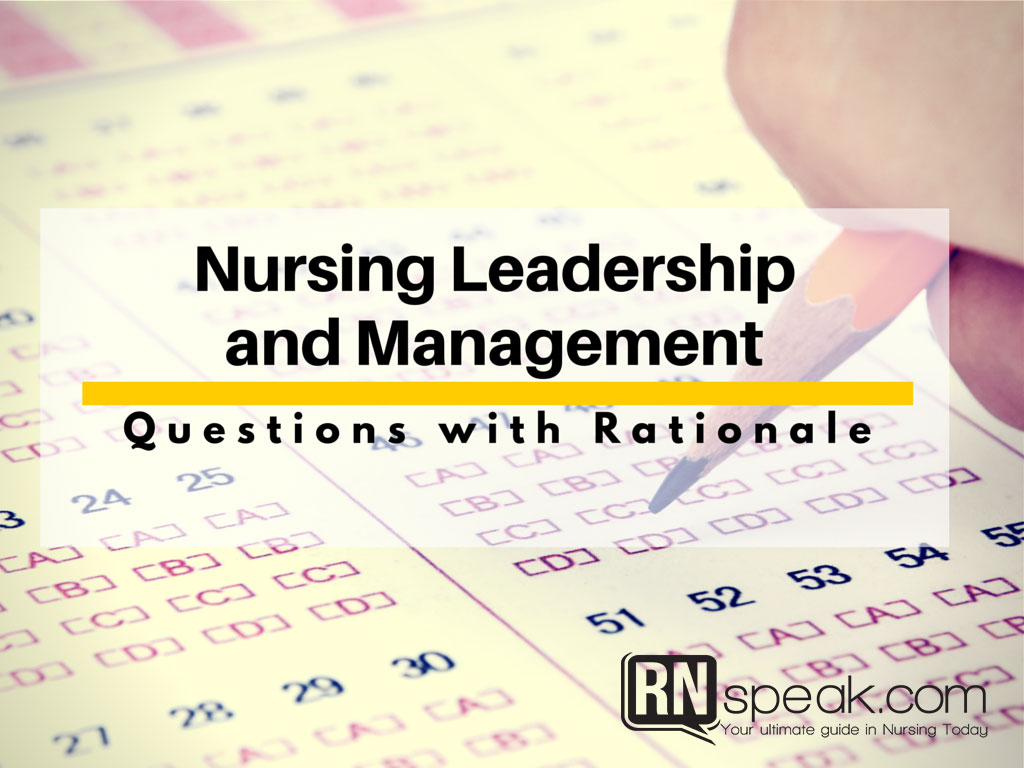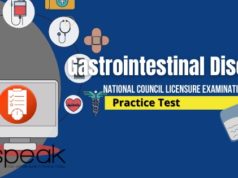This nursing practice is about theories and principles regarding how the nurse functions independently and in collaboration with other nurses and various health team members in various setting.
The scope of this 25 – item practice test involves the following topics:
- Types and style of leadership
- Theories of leadership
- Management process and functions
- Patient classification system
- Types of staffing
- Modalities of patient care
- Communication process in management
- Conflict and conflict management
Nursing Leadership and Management Test
Situation: You are not new in your department and you had been there for almost three years. Miss A, your previous nurse manager was considered strict and authoritative in implementing the protocols in your area. She would make your schedule fixed unless you will inform her two weeks before for any change of shift. On the contrary, your new nurse manager, Miss B, schedules a monthly staff meeting for any significant matters in your department. She is not so lax but makes it up to collect suggestions from all of you before making decisions.
1. If you are to choose which one of your nurse managers described above reflects a democratic type of leadership, who is she?
A. Miss A
B. Miss B
C. Both of them
D. None of the above
2. What leadership style did Miss A utilized to maintain a strong control in the department?
A. Laissez-faire
B. Democratic
C. Collegial
D. Autocratic
3. There are nursing students who are conducting their study on leadership styles in your unit. One of the questions included is: What do you think is the most effective leadership style that can be used during emergency situations?
A. Democratic
B. Laissez-faire
C. Autocratic
D. Supportive
4. What are the qualities that define a leader who uses laissez-faire?
A. She involves the group in planning and in decision making
B. She oversees everything to come up with a good quantity and quality of output but provides little autonomy and self-motivation to her members.
C. She tends to be passive and puts the responsibility of decision-making on others.
D. She would foster independence in your team by promoting motivation and creativity.
5. This is a common trait of a leader which is defined as his ability to possess honesty, responsibility, and maturity in the working area.
A. Integrity
B. Personality
C. Intelligence
D. Flexibility
6. You are the head nurse in the pediatric department. Your roles in the planning process in the hospital include the following, except one:
A. Act as a link between higher-level managers and non-managers
B. Directly responsible for the actual production of nursing services
C. Represent the organization
D. Answers C & B
7. What is true about the patient classification system or PCS?
A. It is a method of grouping patients according to length or duration of nursing care
B. It is a measuring tool used to describe the progress of a patient’s status
C. It depends on the complexity of nursing care requirements of the patient
D. All of the above
8. You are asked by your instructor to discuss about Contingency Theory. What should you include in your discussion?
A. It is a theory in leadership that views the pattern of leader behavior as dependent on the interaction of the personality and the needs of the situation.
B. It considers that leaders must provide followers a sense of security and approval and discipline to be successful in an output.
C. It emphasizes that both leaders and followers should act on one another to raise their motivation.
D. It states that leadership qualities inspire followers to be motivated in what they do.
9. In planning, conceptualizing the purpose and the aspirations of the organization is essential. What statement gives a false description of a vision?
A. It reflects what the organization wants to be
B. It is written to magnify the various activities and it is projected with a broad time frame
C. It reflects why the organization exist
D. It uses action words in the present tense
10. Isabelle, your co-worker, is a newly hired nurse. She asked you about a centralized staffing system.
A. The head nurse or the supervisor does the scheduling of personnel.
B. Schedule is based on the needs of the patients and the knowledge of the personnel.
C. You can readily rearrange your schedule as needed.
D. The scheduling is planned and made by the nursing director.
11. In the hospital, your department is using the functional method of patient care modality. What is it all about?
A. One nurse is responsible for giving bedside care, another one for administering medications and another one for treatments and so on.
B. It is a one on one constant patient care for a period of time.
C. The nurse has the responsibility for giving nursing care to the client from admission until discharge
D. A team leader has the responsibility for coordinating the total care of a group of patients.
12. It corresponds to moderate care or category 2 in the patient classification system, if:
A. The patient is unstable and acutely ill and has high demands for nursing care
B. The patient is already recovering from a serious illness and requires some assistance.
C. The patient is only requiring diagnostic studies and minimal therapy.
D. The patient needs close monitoring and requires complete care in most activities
13. It is a managerial function that indicates leading the staff in the most effective method.
A. Planning
B. Directing
C. Organizing
D. Controlling
14. Which describes an informal leader?
A. Anna who is appointed because of her competencies and continuing education
B. Maria who becomes the leader of the team because of her years of experience in the department
C. Eduard who is considered the leader of the team since he was given the legitimate authority to act as one.
D. Alexandra who is chosen by the administration because of her age and knowledge in the area of work.
15. Why is good communication important in managing personnel?
A. It motivates personnel to do their jobs well
B. It promotes independence and collaboration
C. It fosters influence and power
D. All of the above
16. Downward communication is described below. Which one is correct?
A. The communication is between two supervisors
B. The flow of communication is from the head nurse to the supervisor
C. The flow of communication is from the chief nurse to the head nurse
D. The flow of communication is from the staff nurse to the chief nurse
17. During controlling and evaluating phase, the following are quality improvement methods utilized by institutions. Which one refers to a review process used by healthcare organizations to assure that the hospital may provide care to clients?
A. Credentialing and licensing
B. Standards of care
C Clinical pathways
D. Benchmarking
18. Which type of conflict management technique is described as cooperating and that one side gives in to the other?
A. Avoiding
B. Accommodating
C. Competing
D. Compromising
19. The management theorist who developed the 14 principles of management is:
A. Frederick Taylor
B. Max Weber
C. Mary Follet
D. Henri Fayol
20. What are the tasks that should not be delegated to a non-professional staff?
A. Doing the vital signs
B. Turning the client every two hours
C. Grooming and bathing the client
D. Assessment of neurological deficits
21. You are asked by your instructor to differentiate between a leader and a manager. Which one is incorrect?
A. A leader is focused on purposes but a manager is focused on structures and processes.
B. A leader does the right thing and a manager does each task the right way.
C. A leader has a short term view while a manager views work in long term duration
D. A leader rely on trust while a manager relies on control
22. Supervision and delegation fall to what phase of the management process?
A. Organizing
B. Directing
C. Controlling
D. Planning
23. What type of conflict refers to when there are two or more opposing incompatible demands that arise and priority differences affect the resolution of the conflict.
A. Interpersonal conflict
B. Organizational conflict
C. Intrapersonal conflict
D. Answers A & B
24. What is not a characteristic of an organizational chart?
A. It shows the division of work
B. It shows the workload of each personnel
C. It reflects the type of work of each staff
D. It delineates the groupings according to the type of work
25. What kind of staffing is considered the most common pattern and the oldest type?
A. Cyclical staffing
B. Full-time equivalent staffing
C. Conventional staffing
D. Decentralized staffing









I would like more .So nice
It was very relevant but i need more sample questions of directing & controlling in nursing management for postgraduate studies.
thank you
I would like more tests